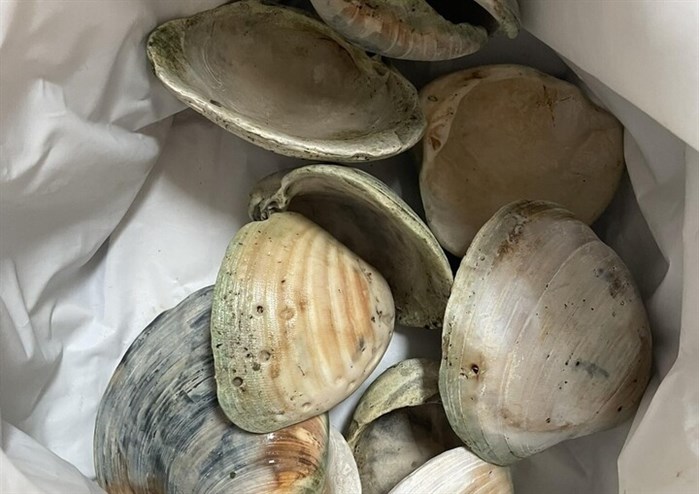
These clam shells were found by kids playing on the shoreline in Shuswap Lake in August.
Image Credit: SUBMITTED/ Melissa Mae James
September 11, 2025 - 6:00 AM
Kids playing on the shore of Shuswap Lake this summer found a handful of clam shells roughly the size of a palm, but it's difficult to determine what species they are.
“I am not 100% confident in the ID of these shells due to their weathered state,” field operations coordinator with the Columbia Shuswap Invasive Species Society Nolan Novotny said in an emailed statement.
The shells likely belong to one of two clam species living in Shuswap Lake, the native fingernail clam — also called a pea clam — or the invasive clam known as the Asian clam.
Native clams are more oval in shape with thinner shells, while the invasive clams are triangular and have elevated growth rings. The native clams are roughly a centimetre long while the invasive clams are typically less than 2.5 cm, however they can grow up to 6.5 cm long.
“The invasive clam is typically much larger than the native fingernail clams, although the juveniles can sometimes be confused,” Novotny said. He forwarded the photo of the Shuswap Lake clams to a provincial specialist for identification.
Invasive clams were first detected in BC in 2008 and confirmed in Shuswap Lake in 2020. They are native to southeast Asia and parts of central and eastern Australia, Africa, Indonesia and Turkey.
Yellow-green to light brown in colour, the clams are found in brackish to freshwater bodies, canals and reservoirs at the sediment surface or slightly buried in silt, sand or gravel. Their life span is 1 to 7 years and they can self fertilize and reproduce rapidly, with a single clam producing up to 70,000 eggs per year.
These invasive clams are also found in numerous other provincial waterbodies including Cultus Lake, Kootenay River, Osoyoos Lake and Sproat Lake, according to an emailed statement from the Ministry of Water, Land and Resource Stewardship. The ministry was unable to confirm the ID of the clams in the photo.
While extensive surveys for the invasive clam were done when first discovered in Shuswap Lake, there currently is no targeted monitoring.
Novotny said the invasive clams are edible.
"While invasive clams are technically edible we do not encourage the public to consume them as they may accidentally consume the native threatened species," he said.
To date, invasive mussels like the zebra, quagga and golden mussels have not been detected in any BC waters, according to the provincial Invasive Mussel Defense Program.
To help prevent the spread of aquatic invasive species, any boat or equipment moved between waterbodies should be cleaned, drained and dried first. In BC, it is against the law to move boats to waterbodies without pulling out the plug first.
If the public finds shells or live aquatic species suspected to be invasive, they can take a picture and report where they found them to the province here.
To contact a reporter for this story, email Shannon Ainslie or call 250-819-6089 or email the editor. You can also submit photos, videos or news tips to the newsroom and be entered to win a monthly prize draw.
We welcome your comments and opinions on our stories but play nice. We won't censor or delete comments unless they contain off-topic statements or links, unnecessary vulgarity, false facts, spam or obviously fake profiles. If you have any concerns about what you see in comments, email the editor in the link above. SUBSCRIBE to our awesome newsletter here.
News from © iNFOnews, 2025